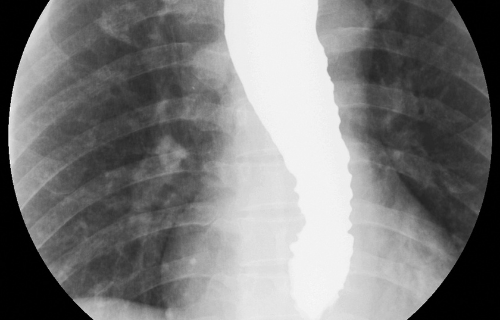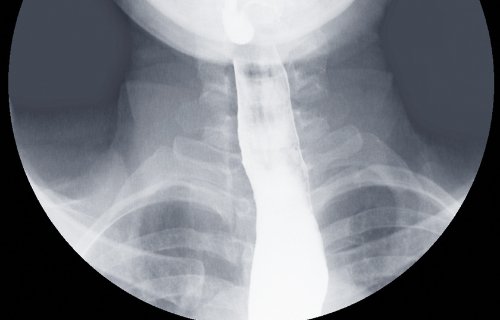Difference Between Achalasia and Stricture

Achalasia and strictures can both occur in the oesophagus. Although these conditions involve the same anatomy, these are significantly different. Achalasia involves the inability of a ring-shaped muscle in the oesophagus to relax, whereas an oesophageal stricture refers to narrowing or tightening of the tube of muscle that makes up the oesophagus. The symptoms of the two conditions may be very close in presentation, but there are specialized tests which are key indicators of which condition the patient is suffering from.

Difference between achalasia and stricture
Definition of achalasia and stricture
Achalasia is a condition that occurs when the muscle of the oesophagus becomes affected. When this condition occurs, the lower ring of muscle in the oesophagus (referred to as the lower oesophageal sphincter) develops the inability to relax. The result of this is that the inlet into the stomach is contracted and no food can pass into the stomach.
A stricture refers to the tightening and shortening or narrowing of a tube in the body. With reference to the oesophagus, an oesophageal stricture is when the muscle which comprises the oesophagus becomes narrow and tight in structure. This makes it difficult for anything to pass down the throat and connect to the stomach. Oesophageal strictures can be either benign and show slow progression, or cancerous and show rapid worsening.
Signs and Symptoms of achalasia and stricture
When suffering from achalasia patients often present with the following:
- Finding difficulty when swallowing food (both solids and liquids)
- Retained food that is regurgitated and could regurgitate into the lungs at night causing a medical emergency
- Sensation of discomfort in the chest or a sharp pain in the chest without cause
- Heartburn which is not relieved by treatment
- Weight loss due to lower intake of food
Oesophageal strictures may present an array of symptoms depending on the type and cause, these are potentially as follows:
- Difficulty when trying to swallow liquid or solids
- Sensation that food is sticking in the throat
- Episodes of choking more and more frequently
- A feeling of burning along the throat or in the neck
Diagnosis of achalasia and stricture
Achalasia is diagnosed based off symptoms described by the patient, through X-ray studies, with a barium swallow, via oesophageal manometry to measure the muscle function in the oesophagus, using endoscopy where a camera provides a visual image inside the oesophagus directly, and various scans to search for abnormalities or growths.
Strictures can be diagnosed similarly to how achalasia is diagnosed. This is based off described symptoms, X-ray studies with a barium swallow, using endoscopy, and through oesophageal manometry.
Causes of achalasia and stricture
The causes of achalasia are usually genetic and inherited. An abnormality of the immune system can also cause the body to have an autoimmune response and damage itself
The causes of an oesophageal stricture are usually an inflamed oesophagus caused by an allergic reaction or problems with the immune system, gastroesophageal reflux where acid damages the oesophagus, cancer of the oesophagus, ulcers, medications (such as antibiotics and certain anti-inflammatory drugs), surgical procedures (more specifically, scarring after surgery), and radiation therapy.
Treatment of achalasia and stricture
Treatment of achalasia can be effective and include oral medications, oesophageal dilation where the sphincter is stretched by a balloon, injecting Botox directly into the sphincter muscle to relax it, and surgery where the sphincter is cut (oesphagomyotomy).
For the treatment of an oesophageal stricture, the general go-to option is oesophageal dilation: a procedure where a balloon is used to widen and open the area which has narrowed
Table of comparison between achalasia and stricture

Summary
Achalasia and oesophageal strictures both involve the oesophagus. Achalasia refers to a tightening of the sphincter muscle, preventing food from entering the stomach. Oesophageal stricture refers to a condition where the actual muscular tube of the oesophagus becomes tight, shortened and narrowed, preventing food from passing down through the throat. Both conditions are diagnosed with similar tests, many of them overlapping in treatment too. However, the mechanism of each condition is unique to itself.
FAQ
Is achalasia a stricture?
Achalasia is not a stricture. Achalasia involves the ring-like muscle at the stomach inlet which tightens up, whereas oesophageal stricture involves the entire tube-like muscle which makes up the length of the oesophagus narrowing, shortening, and tightening.
What are the 3 types of achalasia?
There are three distinct types of achalasia which are measured and classified using high-resolution manometry. This includes measurement of muscle thickness and the contraction and relaxation patterns which occur within the muscle layers. The three types can be characterized as follows:
- Type 1 (classic): where there is a level of minimal contraction in the oesophageal area, this is also referred to as minimal oesophageal pressurization
- Type 2: where there are intermittent phases of panesophageal pressurizations, this is also referred to as oesophageal compression
- Type 3 (spastic): where there is a presence of early-onset or spastic oesophageal contractions at the distal end
Each of the three types of achalasia are largely distinct in their response to both medical and surgical treatment. It is of high importance to classify which type of achalasia is present in a patient, as this would be of major benefit in the effective choice of treatment and strengthen future research on the condition.
What is a stricture?
A stricture refers to the abnormal tightening, shortening or narrowing of a bodily passage. It can occur in regions such as the oesophagus linking to the stomach, or passages such as the urethra which provides linkages in the urinary tract where it allows for urine to exit the bladder and then the body. When a stricture occurs in a region such as the urethra, it can make urination a struggle to complete. Just as in the oesophagus, where strictures result in the struggle to eat and/or swallow.
What is an oesophageal stricture?
An oesophageal stricture is the occurrence of abnormal narrowing of the passage from the mouth to the stomach, or the abnormal tightening and shortening thereof. This condition can result in severe limitations of liquids and foods travelling to the stomach and is often experienced alongside the sensation of not being able to swallow or the feeling of having food get stuck in the throat region.
- Difference Between a Cochlear Implant and Normal Hearing - October 4, 2022
- Difference Between Obstructive and Restrictive Spirometry - September 11, 2022
- The Difference Between White Box and Black Box Testing - September 11, 2022
Search DifferenceBetween.net :
Leave a Response
References :
[0]Cleveland Clinic. Esophagael Strictures. https://my.clevelandclinic.org/health/diseases/21456-esophageal-strictures#symptoms-and-causes
[1]Pandolfio, John., Kwiatek, Monika., Naelis, Thomas, Bulsiewicz, William., Post, Jennifer and Kahrilas, Peter. Achalasia: A New Clinically Relevant Classification by High-Resolution Manometry. Gastroenterology. 2008, vol. 135, no. 5, pp:1526-1533.
[2]Patel, Dhyanesh., Lappas, Brian and Vaezi, Michael. An Overview of Achalasia and Its Subtypes. Gastroenterology and Hepatology. 2017, vol. 13, no. 7, pp: 411-421.
